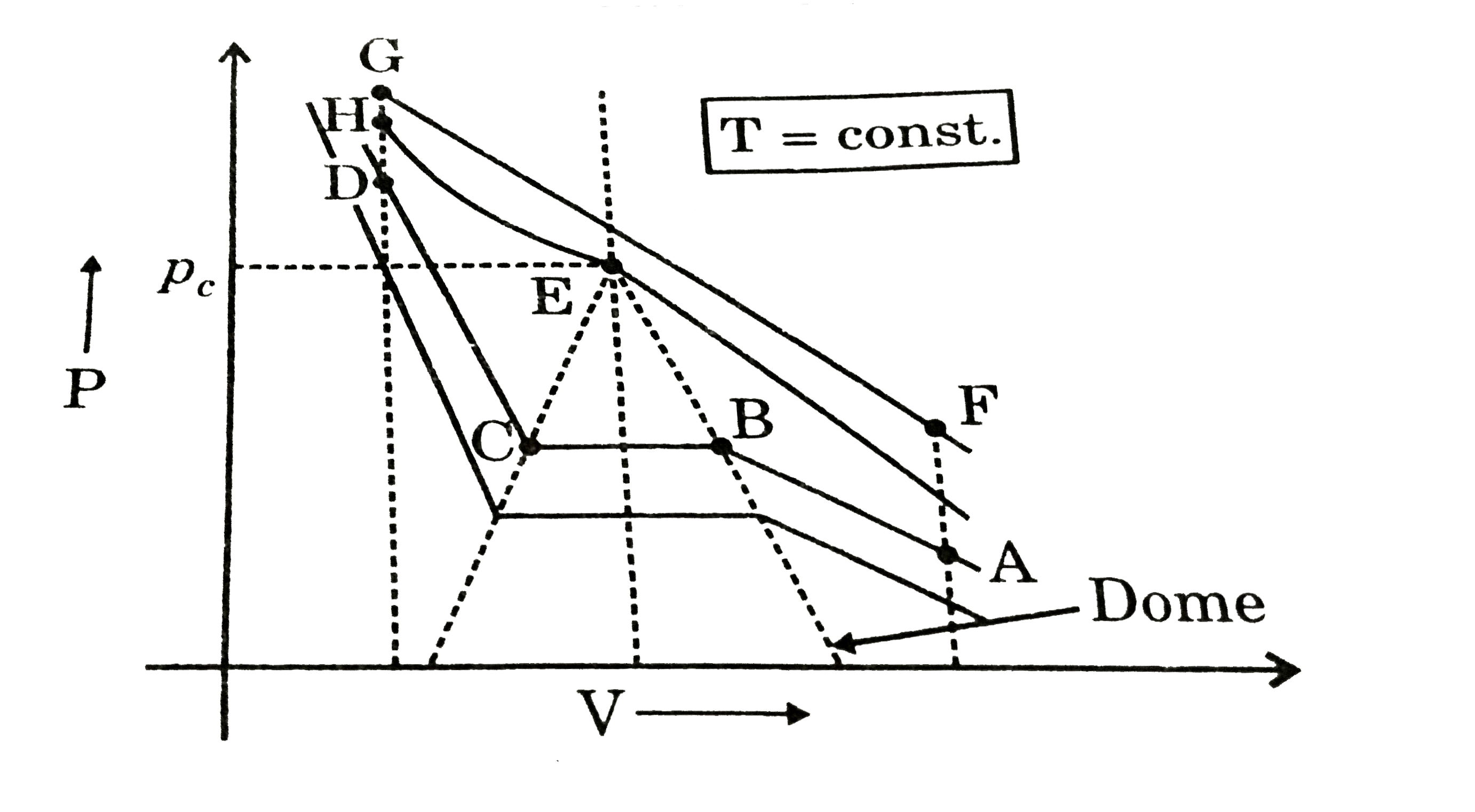Isotherms of carbon dioxide gas are shown in Fig. Mark a path for changing gas into liquid such that only one phase (i.e., either a gas or a liquid) exists at any time during the change. Explain how the temperature, volume and pressure should be change to carry out the change.
Text Solution
It is possible to change a gas into a liquid or a liquid into a gas by a process such that there is a single phase present always.

e.g., In figure given above, we can move from A to vertically by increasing the temperature, then we can reach the point by compressing the gas at constant temperature along the isotherm (isotherm at ). The pressure will increase.
Now, we can move vertically down D by lowering temp. As we cross the H point, we get liquid on critical isotheron. Thus, at no stage during the process, we can through two - phase region.
These process is carried out at the Tc, in which substance always remains in single phase. This is called continuity of state between the gaseous and the liquid state.
|
Topper's Solved these Questions
- STATES OF MATTER BOOK - KUMAR PRAKASHANCHAPTER - STATES OF MATTER EXERCISE - QUESTION PAPER FROM MODULE (SECTION - A)
4 Videos
- STATES OF MATTER BOOK - KUMAR PRAKASHANCHAPTER - STATES OF MATTER EXERCISE - SECTION - D SOLUTION OF NCERT EXEMPLAR PROBLEMS (Assertion and Reason)
6 Videos
- SOME BASIC CONCEPTS OF CHEMISTRYBOOK - KUMAR PRAKASHANCHAPTER - SOME BASIC CONCEPTS OF CHEMISTRYEXERCISE - Section - D (Solutions of NCERT Exemplar Problems) (Long Answer Type Questions)
4 Videos
- STRUCTURE OF ATOMBOOK - KUMAR PRAKASHANCHAPTER - STRUCTURE OF ATOMEXERCISE - QUESTINS PAPER FROM MODULE (SECTION -D)
2 Videos
Similar Questions
Knowledge Check
One mole of an ideal gas undergoes an isothermal change at temperature 'T' so that its voume V is doubled. R is the molar gas constant. Work done by the gas during this change is
ART log4BRT log2CRTlog1DRT log3For the given graph of real gas: What should be the pathto change a gas into a liquid or vice-versa in which always a single phase is present ?
 AA→F vertically then F→G (isothermally) then G→DBA→B (isothermally) then F→G (isobarically), then C→D (isothermally)CD→H→G then G→F (isothermally) then F→A verticallyDNone of the above
AA→F vertically then F→G (isothermally) then G→DBA→B (isothermally) then F→G (isobarically), then C→D (isothermally)CD→H→G then G→F (isothermally) then F→A verticallyDNone of the aboveAmount of energy required to change liquid to gas and vice versa without any change in temperature is termed as .......... ..
ALatent heat of fusionBLatent heat of vapourizationCHeat capacityDSpecific heat capacity
The pressure of a gas is increased 2 times. What should be the change in its volume so that the temperature and number of moles remain constant?
View SolutionThe pressure of a gas is increased 2 times. What should be the change in its volume so that the temperature and number of moles remain constant?
View SolutionThe pressure of gas is increased 2 times. What should be the change in its volume so that the temperature and number of moles remains constant ?
View SolutionThe pressure of gas is increased 2 times. What should be the change in its volume so that the temperature and number of moles remains constant ?
View SolutionIn a process, the pressure of a gas remains constant. If the temperature is doubles, then the change in the volume will be.
View Solution
